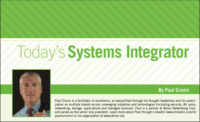
Few people remain in the monitoring industry that remember when a dedicated pair of copper wires from a protected premises to a central station was needed to remotely monitor a subscriber’s fire or burglar alarm system. Yet many have read about these communication methods used in the early 20th Century, and have heard how expensive and labor-intensive they were.
The invention of the digital communicator in the 1970s changed the entire landscape of monitoring, because alarms could be transmitted over what the telcos called Plain Old Telephone Service, or POTS lines. This made it possible for a central station in Florida to monitor an alarm panel in Alaska.
Once again, the monitoring industry is in the process of a transformation because of the widespread prevalence of the Internet and Internet Protocol (IP) technologies. With IP, an entirely new range of solutions is possible and with it, an entirely new host of monitoring services.
“A lot of voice over IP (VoIP) technologies and cellular GSM backup systems are replacing expensive POTS technology, while all the IP-based cameras, DVRs and network solutions now available are allowing for easy set-up, deployment, configuration and monitoring,” says Kenny Savoie, director of operations, Acadian Monitoring Services, Lafayette, La. “Basically a whole new evolution of security is unfolding as we speak.”
This next generation of monitoring services is largely based on the Internet and the capabilities it provides. Added to traditional “signal-based” monitoring of burglar and fire alarm systems are remote video monitoring, access control monitoring, PERS monitoring and much more.
“We are offering these services because there is a need in the market for them,” says Mitch Clarke, vice president, Monitronics International, Dallas.
Central stations investing in the new technologies and making them available to dealers are responding to a growing consumer demand and awareness of the solutions available. That is why it is so important for dealers to pay attention.
“Consumer demand is there, and that is really what is driving these advances,” says Savoie. His company receives calls about the services all the time – from consumers, not just dealers. “We are strictly a third party monitoring company, but we are getting calls from consumers directly all the time,” he says. “They are not requesting, but rather demanding these services, so we are trying to educate our dealers that consumers are driving us to get these products up and going.
“Customers want easy access to advanced solutions to solve their risk management, asset protection and security needs,” says Jacky Grimm, director of security solutions for Diebold Security, North Canton, Ohio. “Technology is changing rapidly — and our dealers are expected to be able to offer new services that are of value. We have seen an increased interest in advanced IP services, which provide dealers another source of recurring monthly revenue (RMR) and also opens up new markets for dealers. For instance, those customers who do not have the infrastructure/manpower for advanced services can now realize the benefits of these services at a lower entry point.”
With the larger possible customer base and growing customer demand, the best advice central stations offer about all the new services and technologies available is, “Don’t get left behind.”
“We will do everything we can to make dealers aware of what we are offering and will collaborate with them and the various vendors to get them the necessary training and other information they need, but ultimately the end users are the dealers’ customers. If they don’t offer these services to their customers, someone else will. Don’t get behind the 8-ball,” warns Savoie.
The Usual Suspects
Video monitoring, remote panel access, remote video storage and monitoring from IP cameras and encoders, remote DVR health checks, energy management and control, hosted access control — they aren’t a secret anymore. They are getting more established by the day, and more customers are aware of them and asking for them. You are hearing about them because the demand is there. Take PERS, for example; it is generally accepted that the already present demand will only continue to grow.
“PERS is a market that is here to stay,” says Woodie Andrawos, executive vice president and co-founder with Michael Schubert of National Monitoring Center (NMC), Aliso Viejo, Calif. “As the aging population continues to increase, the interest and opportunity will only continue to grow.”
But don’t think PERS is just for the senior market. As Kevin McCarthy, national sales manager at EMERgency24, Des Plaines, Ill., points out, there are more opportunities to be had via PERS equipment.
“In addition to the senior citizen market, PERS can be marketed specifically for residential or commercial protection too,” says McCarthy. “For example, if a potential customer balks at the cost (or perceived need) of a full-fledged security system, PERS can act as a dispatching device for emergency situations, i.e. panic, fire or environmental alarms. This is also an option for retail outlets, only requiring a silent-alarm feature and two-way listen-in capability.”
As McCarthy points out, PERS offers very attractive margins because all that’s needed is a working electrical outlet and a telephone line.
“With all the possibilities that PERS presents, it is time for every security dealer to fully embrace this new revenue stream. With PERS, dealers have the opportunity to build a new market within their existing customer base and their circle of associates,” says McCarthy.
Monitored video services, such as remote monitoring and storage, and verification, also are experiencing higher demand. Video monitoring and video verification are skyrocketing as well.
“Video and the verification market are not going away,” says Andrawos. “Especially with the assistance video provides regarding the response issues and false alarms in the industry. Spurred on by the continued development of the technology as well, there is going to continue to be reinforced interest and an increasing need.”
“The advantages video monitoring and video verification provide to everyone on the supply chain — end user, central station, law enforcement — are too great for the demand not to continue,” says Savoie. “We expect the next two to five years to show tremendous growth in video monitoring. It’s already happening in Europe. It’s only a matter of time here in the United States. Those companies (central stations and dealers and integrators) that begin to take advantage now, in the early stages, are going to be the ones to reap the biggest benefits in the long term.”
Getting Started
As central stations have adapted their platforms and operations to the new technologies, they have done much of the leg work for dealers, making the process of getting started a lot easier.
One misconception is that technology comes with a high price and is difficult to grasp or sell, says Tony Wilson, president, Criticom Monitoring Services (CMS), Longwood, Fla. “The reality is that using the latest in technology often saves companies and their customers time and money and integrates easily into their everyday lives, creating conveniences that are very much needed and appreciated. While it can be easier for larger monitoring providers such as CMS to explore and implement the latest technologies, even the smallest dealer can benefit from the end result and revenue opportunities.”
Savoie sees the new technologies as an offering that can add a lot, with less investment because of the investment the central stations have already made, incurring the cost of the technology, implementation and support. “In the case of our dealers who understand the value of these services, they are adding monthly revenue dollars in a much greater proportion than standard monitoring, while offering their customers the most advanced technology available.”
Benefits for You, Benefits for the Industry
Educating yourself on IP-based products and services that monitoring stations may offer will help you maximize the relationship you have with your customer, provide consumer education, and bolster the industry in the process.
“For full adoption, all these products still require an installer-led installation, which is good for industry,” says Mitch Clarke at Monitronics International. “Installers put a face on the industry, and they also provide the education that customers need about the systems that keep them using the systems — and that’s the magic, keeping customers using the systems.”
Clarke sees increased customer use as a compelling reason to begin offering the new technologies. “We believe that the advent of the Internet, the mobility of the security system and the new services available are hugely important for the industry because not only is it a driver for people to use their system more frequently, but we think its effects will be seen in attrition levels as well. The more people interact with their systems because it is easy, and the more excited they become about what the systems can offer, the more likely they are to keep those systems.
Clarke also points out that dealers who can offer new services to customers differentiate themselves and, in addition to building into their company, build into the industry as well.
“More and more consumers have heard something about the services out there, and the dealers who can offer those services to them really stand out,” Clarke says. “The new services are not for everybody. The people who only want to make money on day one aren’t interested, but the people who want to make continued sales and upgrades and have a reason to go back and stay in contact with their customers are interested. They will help us get the consumer to make a behavioral change and learn to use the product in a more advanced way, staying engaged with their systems. Those dealers who really understand that value will get involved and make their business better and healthier — and the industry as well.”


